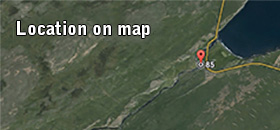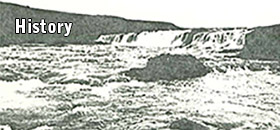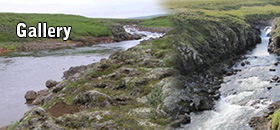Description of Miðfjarðará and Litla-Kverká and the rivers' main fishing pools
Miðfjarðará gathers and forms on the Mælifell heath, to the northwest below Kistufell mountain. It has a large river basin and can grow quickly in heavy rain. Miðfjarðará river and Litla-Kverká river meet to the west, just below the deserted farm Kverkártunga. Quite far up on the Miðfjörður heath is the lake Djúpavatn (Deep Lake) and from it runs a small stream, called Litlilækur (Small Creek) into Miðfjarðará river. Large trout has been caught in the lake, however there are not many sources on angling in the lake. It has not been practiced much.
Miðfjarðará runs quite a distance through a ravine down from the Miðfjörður heath and down to the junction where it meets Litla-Kverká. Fálkafoss (Falcon waterfall) in Miðfjarðará lies just above the river junction. Fish swims up to the water fall, and also up Litla-Kverká. It was formerly believed that the salmon only swam up Litla-Kverká to the waterfall, almost a kilometer above the junction, whereunder is Klapparhylur fishing pool. It has now been discovered that salmon jumps that waterfall and from there it can swim more than two kilometers up stream, all the way up to the waterfall Brúarfoss. Under that waterfall is Brúarhylur fishing pool, horseshoe-shaped, surrounded by cliffs and very deep. It is a spectacular sight to watch the salmon try to jump the waterfall. The most lively salmon jumps up under the edge of the waterfall, only to drop down into the abyss again.
There are about three kilometers from the ocean river mouth and up to Fálkafoss waterfall. The distance to Klapparhylur pool in Litla-Kverká is a bit shorter. The salmon gathers under Fálkafoss. The water pool under the watefall is large and calm, and ends in a fraction where rocks have collapsed into the river. There below a string formes. The salmon mainly keeps itself above the fracture or string. It is relatively easy to screen the pool for fish. One can often see a hoard of salmon lying there, somtimes very large fish, salmon approaching thirty pounds. There, they hold up during the summer, occasionally seen but rarely give an opportunity for a catch.
The fishing pools, counting from top down to the ocean, are as follows:
Fálki (Falcon), as pool is often called, is a tempting fly fishing spot. One must stand on the west bank to fish.
Varphylur pool (Nesting pool) is next, where the river falls off a small step down into the pool and creates a string that fades out in calm. This is a large-stoned fishing spot. The salmon can be widely spread in the pool, sheltered by large rocks and can be hard to spot, and the approach to the pool for anglers is also somewhat problematic.
In order to get to the next pool, Skrúður, one must return the same way out of the canyon and down back again just above Skrúður pool. The river falls from rapids into the pool where it is relatively narrow and a large rock lies on the east side in the pool. Skrúður is 50-60 meters long, very deep above and calmer below, ending where rocks have fallen from the canyon walls. After that, the river speeds up again. In Skrúður there are many places for the salmon to lie around, mainly by the east bank, especially just before the water begins to exit the pool. Skrúður is a good fly fishing spot, albeit the bank is a bit narrow.
Below a bend in the canyon the river falls from rapids down into a sort of a saucepan or pot, a sheer cliff stands to the east, and there is Bjarghylur pool (Cliff pool).
Next is Efri-Ármótahylur pool (Upper-River Juntion pool) above the mouth of Litla-Kverká. High banks are on each side of it and rocks stretch into the river to the west, which one has to wade around. The pool is very deep at the top where the water flows in, but then becomes shallower and bare rocks are at the lower part of the pool and it is easy to spot fish there. The salmon sometimes stops here to rest while going upstream, and one can sometimes catch one ore two salmon. Now we come down from the ravines and the river changes its appearence. However the rivers banks are still quite high, especially to the west.
Neðri-Ármótahylur pool (Lower-River Juntion pool) is rather shallow, the river flows on a pedestal boulder twined with pools or bowls here and there. Fly fishing goes well in this pool. The lower part of the river shifts between rocky bottom, gravel and boulders.
Above Draugafoss waterfall (Ghost waterfall) which falls from a two meter high pedestal, the river splits in two. The main branch streams down by the east bank into the waterfall itself. Fishing by the waterfall pool is done from the east side. In the pool, which is relatively shallow, a lot of char could once be caught there, but the char has greatly reduced swimming up the river in recent years. A gravel bluff runs diagonally from west into the river. The bluff can be waded on. Just off of the bluff, there can still be hope of catching char.
Straight down from the old fishing-lodge, which stands within Rauðalækur creek is Steinboga poll (Stone Arch pool). In the river there is a stone dyke across the bottom. Fishing can be done both above and below the dyke. A curve is in the river above the pool and a large rock. The river mainly runs east of the rock and then over the stone dyke into a deep puddle. Below that the river becomes shallower and widens, runs on bedrock and pans down to the large rock west of the center of the river. East of the rock are two chutes where the river runs through and the salmon stops therein.
Then the river flows fast in stones with no fishing areas until down in Háabakkahylur pool (High Banks pool). It has two large rocks whereby the salmon often shelters.
Then the river turns east and then again to the north and runs there on gravel banks. A fishing pool was created there which is called Hölkni (Rock pool). During upstream swimming, the salmon somtimes lingers in the pool.
Below the next step the river slows a little bit down in some rocky hindrances. There is a pool called Þurrkeyrarhylur (Drying Lands pool).
The river flows on through rocks into Húsahylur pool (House pool). There just above is a deserted farm named Miðfjarðarnessel. Húsahylur pool is calm and long, not very deep, it was considered a rewarding fishing pool in the past, but in recent years fishing there, as elsewhere in the lower part of the river, has declined for whatever reason. However, spawning conditions in the river's lower region are much better than up river and apparently spawning salmon seems to travel down from the canyon later in the fall.
Below Húsahylur pool the river starts flowing fast again until one reaches calmer water, where Netahylur pool is (Fishing Nets pool), a great source of food in earlier times. The pool was amended a few years ago and is now wide, long and calm. Fish lies in it scattered, depending on the level of water in the river. Then the river turns sharply to the northwest, to the east side is a high bank while the north bank is low with gravel.
Below the curve a pool is carved into a dark tuff rock. The pool is titled Svartibakki pool (Black Bank pool). It's pretty deep at the top, but down from it lies a chute which opens out into a beautiful and wide calm area. When the water level in the river is at average or more, optimum conditions form there for the salmon. It is very exciting to see turbulance of a big fish being chased a fly fishing hunter. Then the river crosses again and below that bend is an old bridge pillar, which now stands almost in the middle of the river.
On either side of the pillar the river has carved down to form chutes where the salmon somtimes stops.
Below an old arch bridge, which lies across the river, is Brúarhylur (Bridge pool), stony and long. One can fish in it almost down to the new bridge on the main highway, but the main fishing is done high in the pool basin.
Then one arrives at the last fishing pool in the river, Réttarhylur. Due to road construction and rock removal it has deteriorated and is now only a shadow of its former self.
There is no fishing in the mouth of the river.




